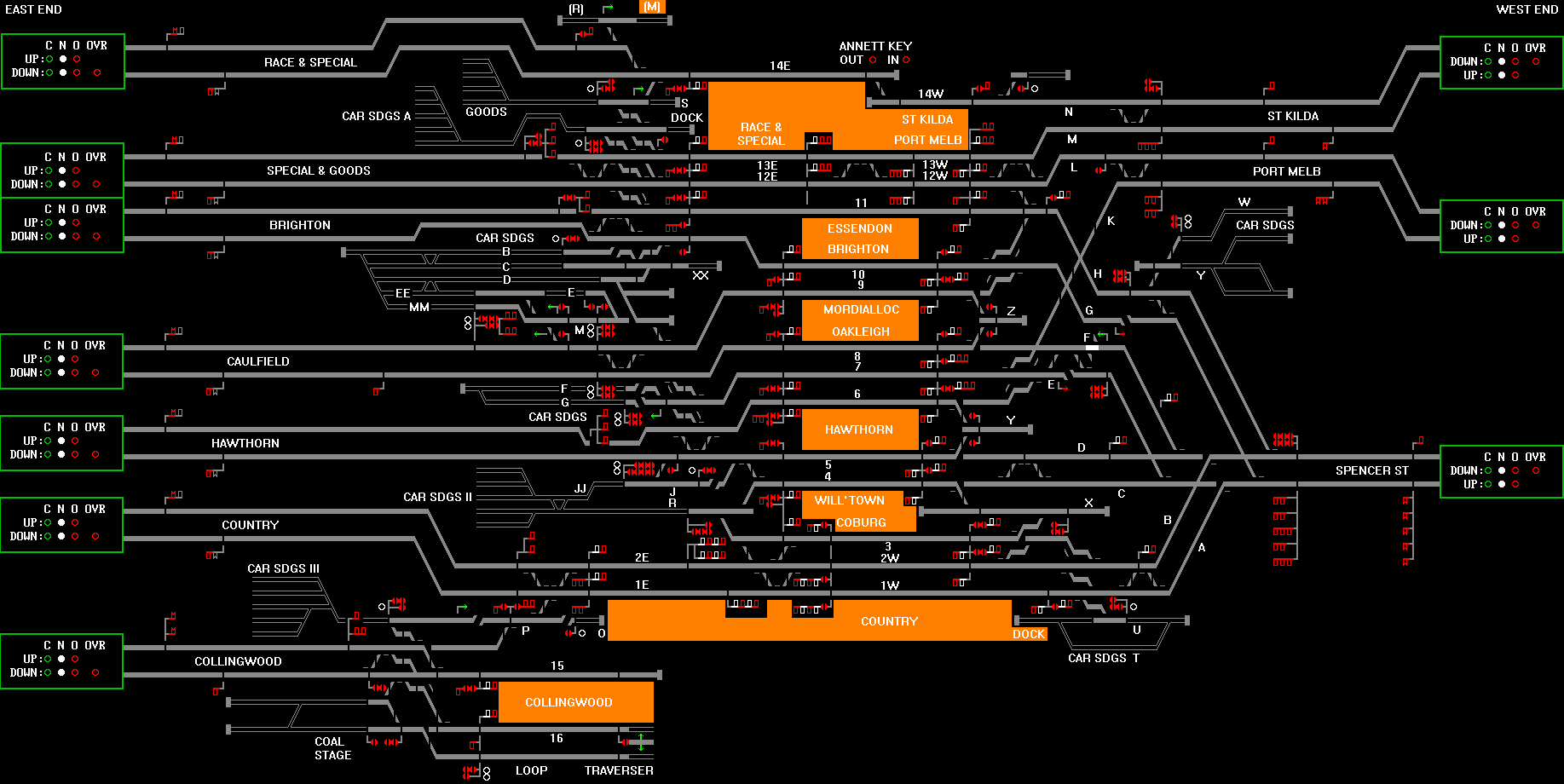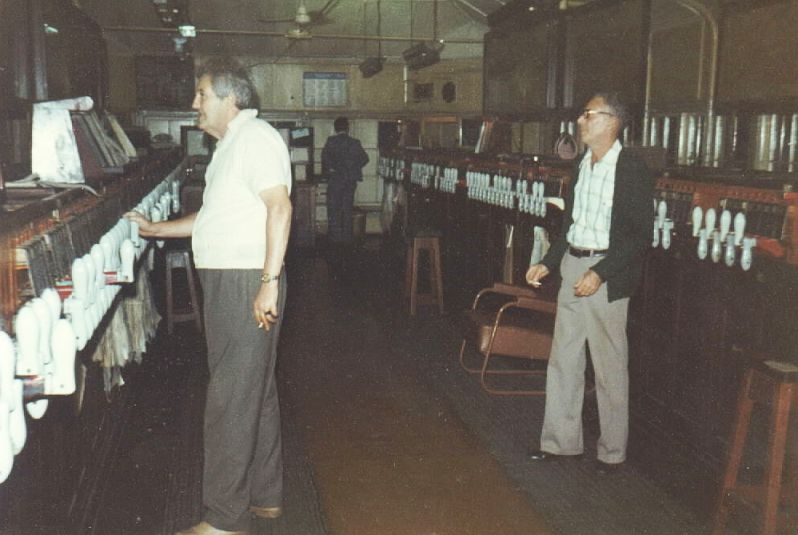Page 1 of 1
| Flinders Street Station, Melbourne, 1910 20/04/2022 at 12:09 #146224 | |
|
Anothersignalman
115 posts |
As attached. The real area at this time was worked by four signal boxes, with at least ten signalmen and block recorders at any time: A, 145 signals / 15 controls / 46 points / 37 locks / 1 crosslock / 16 spares, working Port Melbourne, St Kilda and Spencer Street lines B, 65 signals / 4 controls / 20 points / 15 locks / 1 crosslock / 4 spares, working Race, Special and Brighton lines C, 112 signals / 10 controls / 26 points / 25 locks / 11 spares, working Caulfield, Hawthorn and Country lines D, 23 signals / 1 controls / 7 points / 6 locks / 21 spares, working the Collingwood line Net 365 signals / 30 controls / 99 points / 83 locks / 2 crosslocks / 52 spares, total 631 levers. I don't know for sure but I think at the time, Brighton trains ran through to Spencer Street towards Essendon (sharing the line with Williamstown and Coburg trains), while all other suburban trains (Port Melbourne, St Kilda, Oakleigh and Mordialloc from Caulfield, Lilydale, Upper Fern Tree Gully, Riversdale/Ashburton, Darling and Kew at Hawthorn, and Eltham, Reservoir and North Carlton at Collingwood) terminated in their nominated platforms with drop-on or runaround engines. Country trains would have arrived and departed in both directions; further to the west the Country mainlines crossed the Hawthorn lines to give access to those and the Caulfield tracks. Freight from all lines would need to access Port Melbourne and that was also the site of the main loco depot for the city, with batches of light engines running to and from the depot at regular intervals. I also don't know how often the Race tracks were used - that might have been only on weekends or holidays - but they had access to the Hawthorn, Caulfield and Brighton lines further east. The short platform (M) is the mortuary dock, so special trains would occasionally need to access that. 
Post has attachments. Log in to view them. Last edited: 20/04/2022 at 22:43 by Anothersignalman Reason: None given Log in to reply |
| Flinders Street Station, Melbourne, 1910 20/04/2022 at 20:26 #146228 | |
|
DaveHarries
1292 posts |
Nice. Are there still signalboxes at Flinders Street and the other named locations on that layout or is it all controlled from one location nowadays? Dave Log in to reply |
| Flinders Street Station, Melbourne, 1910 20/04/2022 at 20:36 #146230 | |
|
Meld
1116 posts |
 And from the outside a beautiful station Post has attachments. Log in to view them. Passed the age to be doing 'Spoon Feeding' !!! Last edited: 20/04/2022 at 20:43 by Meld Reason: None given Log in to reply |
| Flinders Street Station, Melbourne, 1910 20/04/2022 at 22:40 #146235 | |
|
Anothersignalman
115 posts |
DaveHarries in post 146228 said:Nice. Are there still signalboxes at Flinders Street and the other named locations on that layout or is it all controlled from one location nowadays? Transcripts of the weekly updates are listed here for 1894 to 1994, and I'm working on providing the rest at the moment, though I am considering splitting out the signal box entries distinct from the station area and structure itself. D box was replaced with a power frame fairly early on; it and the three mechanical boxes were later abolished as part of the construction of the City Loop. B and C boxes were demolished during construction of Federation Square (I think), while D box is still buried under there. A box was also abolished in the 1980s and was supposed to be preserved, but caught fire twice and eventually they ended up knocking out one of the brick walls and dragging out the lever frames for scrapping. The remains then sat as a husk for about half a decade before it was rebuilt in a completely different style, and it's now an art gallery. The signalling for the area, along with the rest of the city and a considerable portion of the suburban system, is now centrally controlled from an office building a few blocks away. As an aside, were there any international examples of back-to-back lever frames?  Meld in post 146230 said:
Side note - while they used red bricks on the north face of the building, the south face was supposed to be open balconies under a Victorian-style three-arch glass roof that never got built, so instead they used flattened 44gal kerosene drums to seal in the balconies and create the south-side wall. Log in to reply The following user said thank you: DaveHarries |
| Flinders Street Station, Melbourne, 1910 21/04/2022 at 09:18 #146243 | |
|
flabberdacks
679 posts |
If you're willing to devote the time to it, pulling the signalling and infrastructure changes out and keeping them separate will prove beneficial to someone in the long run. While it's a labour of love, I've been having a monster of a time researching signalling alterations for several in-development NSW sims. Slogging through dribble like "here's the committee for the staff picnic 1992" while looking for signalling information in the weekly notices is draining. Here's a back to back pistol-grip frame at Sydney West Box while we're at it (decommissioned 1979): 
Log in to reply The following user said thank you: Anothersignalman |
| Flinders Street Station, Melbourne, 1910 21/04/2022 at 14:06 #146244 | |
|
Anothersignalman
115 posts |
flabberdacks in post 146243 said:If you're willing to devote the time to it, pulling the signalling and infrastructure changes out and keeping them separate will prove beneficial to someone in the long run. I've split out the entries for A, B, C and D boxes, and removed a handful of interlopers. I now need to find the chainages of the four boxes so I can make their pages show up correctly in the database. Log in to reply |
| Flinders Street Station, Melbourne, 1910 22/04/2022 at 08:09 #146245 | |
|
kbarber
1779 posts |
Anothersignalman in post 146235 said:Plenty in the UK. Liverpool St West Side, one of the pre-1952 Euston boxes (No. 2?), one of the old London Bridge boxes (pre-1920s) spring immediately to mind. I'm sure there were plenty of others. Meanwhile, the Midland Railway had a number of boxes with completely independent back-to-back frames (St Pancras Station, Hendon (at least as late as the 1920s), Mill Hill, Bedford Junction), one each for fast & slow lines and sometimes with bolt locks between the frames as if they were completely separate boxes. At Hendon & Mill Hill the frames weren't strictly back to back; although they faced opposite ways, there was one at each end of a normal-width box. Last edited: 22/04/2022 at 08:10 by kbarber Reason: typo Log in to reply The following users said thank you: flabberdacks, Anothersignalman |